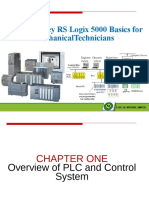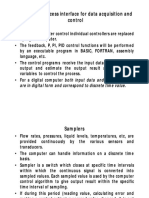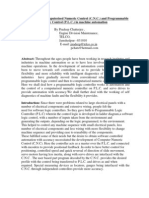Note 1_Basics of Control
Uploaded by
dannyyd1234Note 1_Basics of Control
Uploaded by
dannyyd1234Sequence and Logic Control
Many control applications do not involve analog process variables, that is, the
ones which can assume a continuous range of values, but instead variables that are set
valued, that is they only assume values belonging to a finite set. The simplest
examples of such variables are binary variables that can have either of two possible
values, (such as 1 or 0, on or off, open or closed etc.). These control systems operate
by turning on and off switches, motors, valves, and other devices in response to
operating conditions and as a function of time. Such systems are referred to as
sequence/logic control systems. For example, in the operation of transfer lines and
automated assembly a machine, sequence control is used to coordinate the various
actions of the production system (e.g., transfer of parts, changing of the tool, feeding
of the metal cutting tool, etc.).
Typically the control problem is to cause/ prevent occurrence of
• Particular values of outputs process variables
• Particular values of outputs obeying timing restrictions
• Given sequences of discrete outputs
• Given orders between various discrete outputs
Note that some of these can also be operated using analog control methods.
However, in specific applications they may be viewed as discrete control or sensing
devices for two reasons, namely,
• The inputs to these devices only belong to two specific sets. For example in
the control of a reciprocating conveyor system, analog motor control is not
applied. Simple on-off control is adequate. Therefore for this application, the
motor-starter actuation system may be considered as discrete.
• Often the control problem considered is supervisory in nature, where the
problem is provide different types of supervisory commands to automatic
control systems, which in turn carry out analog control tasks, such that overall
system operating modes can be maintained and coordinated to achieve system
objectives.
Example Explaining Sequence / Logic Control
The die stamping process is shown in figure below. This process consists of a
metal stamping die fixed to the end of a piston. The piston is extended to stamp a
work piece and retracted to allow the work piece to be removed. The process has 2
actuators: an up solenoid and a down solenoid, which respectively control the
hydraulics for the extension and retraction of the stamping piston and die. The process
also has 2 sensors: an upper limit switch that indicates when the piston is fully
retracted and a lower limit switch that indicates when the piston is fully extended.
Lastly, the process has a master switch which is used to start the process and to shut it
down. The control computer for the process has 3 inputs (2 from the limit sensors and
1 from the master switch) and controls 2 outputs (1 to each actuator solenoid). The
desired control algorithm for the process is simply as follows. When the master switch
is turned on the die-stamping piston is to reciprocate between the extended and
retracted positions, stamping parts that have been placed in the machine. When the
master switch is switched off, the piston is to return to a shutdown configuration with
the actuators off and the piston fully retracted.
Comparison between Analog and Sequence/Logic Control
Evolution of Control System
The control system development after the advent of digital computers now
called PC’s took place in the following order as the technology as well as the
difficulties faced by each of them was realized.
1. Open Loop : offline
Here digital computers were applied for acquisition and processing of plant,
laboratory and test field data. At this time operator had to read these data and store
them, which was an offline process for acquisition and processing of data. Here
optimization and feedback control loop of the process was open.
2. Closed Loop : offline
Here set point values were calculated but still manually set by plant operator,
thus offline closed loop control was formed. This was only acceptable when timing
condition of process control is not severe as manual intervention leads to introduction
of time delay in the control of the process.
3. Open Loop : online
In this era of 50’s computers were provided for process interface for data
acquisition and process control, by connecting inputs directly to the computer. But
still set point values of the controller were not being done, thus online open loop
control.
4. Closed Loop : online
Here in the end of 50’s era output elements were also connected to the
computers for online process monitoring as well as controlling. Thus there was data
transfer in both the direct making it the first
first stepping stone towards online closed loop
control and advance control strategies thereby developed.
5. Distributed Dedicated Computers
In the first half of 60’s computers were used for dedicated functions i.e. their
functions were clearly defined like data processing, data acquisition etc. with no
interconnection between them. Data interexchange was only possible via a
transportable medium.
6. Centralized Dedicated Computers
Here the information interexchange which was not possible in the distributed
dedicated computer control was possible by introducing another central computer in
which data from all the dedicated computers come which can be shared later on.
This led to the information exchange but with computational speed and
reliability of computer at stake. This was the advent of PLC (Programmable Logic
Controller)
7. Decentralized Computer System
In the beginning of the 70’s it was accepted that the central computer will be
solving central automation problem only leaving peripheral computers to solve local
problems in their close surrounding, because of which a two stage hierarchical
automation system structure called Decentralized Computer System was introduced .
This was the advent of Distributed Control System (DCS).
You might also like
- Allen Bradley RS Logix 5000 Basics For Mechanical Technicians Manual100% (4)Allen Bradley RS Logix 5000 Basics For Mechanical Technicians Manual195 pages
- Computers and Control - Mechatronic Systems: Energy Conversion External System Computer (Actuators)No ratings yetComputers and Control - Mechatronic Systems: Energy Conversion External System Computer (Actuators)34 pages
- EEEE4102_Lecture 01_Introduction to Controllers_2024_2025No ratings yetEEEE4102_Lecture 01_Introduction to Controllers_2024_20256 pages
- Programmable Logic Controller (PLC) : The Structure and Features of Programmable LogiccontrollerNo ratings yetProgrammable Logic Controller (PLC) : The Structure and Features of Programmable Logiccontroller6 pages
- PLC in Industrial Control: Ing. Marie Martinásková, Ph.D. Ing. Jakub JURANo ratings yetPLC in Industrial Control: Ing. Marie Martinásková, Ph.D. Ing. Jakub JURA65 pages
- Lecture 13 Dated 24 October, 2024 - PLCNo ratings yetLecture 13 Dated 24 October, 2024 - PLC25 pages
- 1.The Digital Computer_28.04.2023_all-1No ratings yet1.The Digital Computer_28.04.2023_all-136 pages
- Programming Industrial Automation Laboratory Manual 2021-22No ratings yetProgramming Industrial Automation Laboratory Manual 2021-2260 pages
- Chapter 9 - Discrete Control Using PLC and PCNo ratings yetChapter 9 - Discrete Control Using PLC and PC17 pages
- Design and Implementation of PLC-Based Monitoring and Sequence Controller SystemNo ratings yetDesign and Implementation of PLC-Based Monitoring and Sequence Controller System9 pages
- Chapter 8: Programmable Logic Controller (PLC) : EG2098: Industrial Electronics and Control &topic 8 1 1No ratings yetChapter 8: Programmable Logic Controller (PLC) : EG2098: Industrial Electronics and Control &topic 8 1 126 pages
- Istributed Ontrol Ystem: Devloped at Reliance IndustriesNo ratings yetIstributed Ontrol Ystem: Devloped at Reliance Industries43 pages
- Programmable Logic Controllers: Richard A. Wysk IE450 - Manufacturing SystemsNo ratings yetProgrammable Logic Controllers: Richard A. Wysk IE450 - Manufacturing Systems42 pages
- Computer Control of Machines and ProcessNo ratings yetComputer Control of Machines and Process646 pages
- A127474955 - 23429 - 4 - 2019 - PLC ProgrammingNo ratings yetA127474955 - 23429 - 4 - 2019 - PLC Programming37 pages
- Distributed Control Systems (DCS) : An Overview: Abstract: This Paper Introduces Different DCS System and TheirNo ratings yetDistributed Control Systems (DCS) : An Overview: Abstract: This Paper Introduces Different DCS System and Their4 pages
- Industrial Drives & Automation Using PLCNo ratings yetIndustrial Drives & Automation Using PLC6 pages
- The Automation - The Following Figure Shows Some of The Basic Categories of Control System ProblemsNo ratings yetThe Automation - The Following Figure Shows Some of The Basic Categories of Control System Problems4 pages
- Application of Computer in Process ControlNo ratings yetApplication of Computer in Process Control39 pages
- Lr2170sa 4ah Specification Sheet TranslatedNo ratings yetLr2170sa 4ah Specification Sheet Translated15 pages
- Group 7 Homework Chap 5 Introduction To POMNo ratings yetGroup 7 Homework Chap 5 Introduction To POM8 pages
- Magnetic Piston Operated Engine: Sumit Dhangar, Ajinkya Korane, Durgesh BarveNo ratings yetMagnetic Piston Operated Engine: Sumit Dhangar, Ajinkya Korane, Durgesh Barve7 pages
- Animation in China History, Aesthetics, MediaNo ratings yetAnimation in China History, Aesthetics, Media273 pages
- 14 1 22 Engineering Datasheet Rse75n A13 RevcNo ratings yet14 1 22 Engineering Datasheet Rse75n A13 Revc1 page
- 03 Wheel Loader Typical Failure Analysis Mannul-AxleNo ratings yet03 Wheel Loader Typical Failure Analysis Mannul-Axle37 pages
- Circular Economy in Spanish SMEs Challenges and Opportunities100% (1)Circular Economy in Spanish SMEs Challenges and Opportunities11 pages
- WWW Who Int/workforcealliance/knowledge/toolkit/33 PDFNo ratings yetWWW Who Int/workforcealliance/knowledge/toolkit/33 PDF1 page
- Allen Bradley RS Logix 5000 Basics For Mechanical Technicians ManualAllen Bradley RS Logix 5000 Basics For Mechanical Technicians Manual
- Control System: Fundamentals and ApplicationsFrom EverandControl System: Fundamentals and Applications
- Computers and Control - Mechatronic Systems: Energy Conversion External System Computer (Actuators)Computers and Control - Mechatronic Systems: Energy Conversion External System Computer (Actuators)
- EEEE4102_Lecture 01_Introduction to Controllers_2024_2025EEEE4102_Lecture 01_Introduction to Controllers_2024_2025
- Programmable Logic Controller (PLC) : The Structure and Features of Programmable LogiccontrollerProgrammable Logic Controller (PLC) : The Structure and Features of Programmable Logiccontroller
- PLC in Industrial Control: Ing. Marie Martinásková, Ph.D. Ing. Jakub JURAPLC in Industrial Control: Ing. Marie Martinásková, Ph.D. Ing. Jakub JURA
- Programming Industrial Automation Laboratory Manual 2021-22Programming Industrial Automation Laboratory Manual 2021-22
- Design and Implementation of PLC-Based Monitoring and Sequence Controller SystemDesign and Implementation of PLC-Based Monitoring and Sequence Controller System
- Chapter 8: Programmable Logic Controller (PLC) : EG2098: Industrial Electronics and Control &topic 8 1 1Chapter 8: Programmable Logic Controller (PLC) : EG2098: Industrial Electronics and Control &topic 8 1 1
- Istributed Ontrol Ystem: Devloped at Reliance IndustriesIstributed Ontrol Ystem: Devloped at Reliance Industries
- Programmable Logic Controllers: Richard A. Wysk IE450 - Manufacturing SystemsProgrammable Logic Controllers: Richard A. Wysk IE450 - Manufacturing Systems
- Distributed Control Systems (DCS) : An Overview: Abstract: This Paper Introduces Different DCS System and TheirDistributed Control Systems (DCS) : An Overview: Abstract: This Paper Introduces Different DCS System and Their
- The Automation - The Following Figure Shows Some of The Basic Categories of Control System ProblemsThe Automation - The Following Figure Shows Some of The Basic Categories of Control System Problems
- Networked Control System: Fundamentals and ApplicationsFrom EverandNetworked Control System: Fundamentals and Applications
- The Essential Guide to Internet of Things (IoT)From EverandThe Essential Guide to Internet of Things (IoT)
- Magnetic Piston Operated Engine: Sumit Dhangar, Ajinkya Korane, Durgesh BarveMagnetic Piston Operated Engine: Sumit Dhangar, Ajinkya Korane, Durgesh Barve
- 03 Wheel Loader Typical Failure Analysis Mannul-Axle03 Wheel Loader Typical Failure Analysis Mannul-Axle
- Circular Economy in Spanish SMEs Challenges and OpportunitiesCircular Economy in Spanish SMEs Challenges and Opportunities
- WWW Who Int/workforcealliance/knowledge/toolkit/33 PDFWWW Who Int/workforcealliance/knowledge/toolkit/33 PDF

























































































